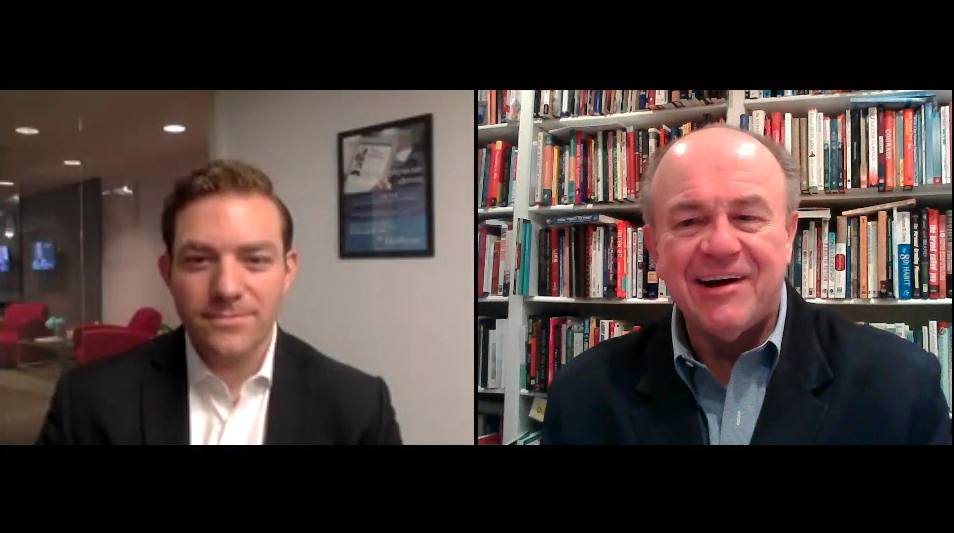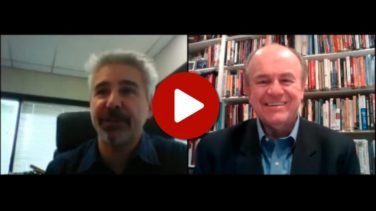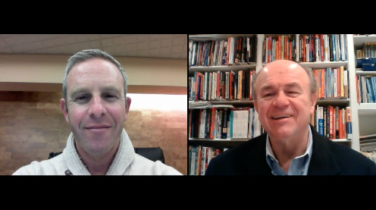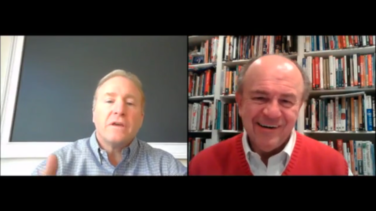PM360 Interview with Erik Dalton, Executive Vice President at Healthcasts from PM360 Online on Vimeo.
Healthcare marketers tend to take a shotgun approach to reaching physicians—just lumping physicians together based on their specialty and blitzing messages out there. Erik Dalton, Executive Vice President at Healthcasts, offers a better approach that combines Big Data with a personal touch. As he explains, just considering a physician’s specialty is not enough as one rheumatologist may see more lupus patients while another might know more about rheumatoid arthritis. Marketers instead need to learn from Netflix and Amazon in order to help physicians overcome the information overload they face by offering them content based on their specialty, patients, viewing habits and more. Erik further explains how marketers can improve their outreach to physicians by customizing each campaign and message to fit that physician. Contact him at erikd@healthcasts.com to learn more.
Transcript
Bud Bilanich: Hi everybody. Bud Bilanich back with another edition of Experts on Call for PM360, and today I’m chatting with Erik Dalton of Healthcasts. And Healthcasts is a pretty cool company. They think of themselves as the “network for physicians by physicians,” and so this has some big pharma marketing and device marketing applications. So first of all, welcome, Erik, and thanks for taking some time to chat with me today.
Erik Dalton: Absolutely. Thank you, as well.
Bud Bilanich: And so let’s talk a little bit about that. That’s an interesting little brand statement you have there. Tell me a little bit more about it.
Erik Dalton: Sure. Yeah. So we really have been in existence for about 13 years now, focused primarily all about physicians, trying to provide them with the most relevant, most up to date, leading-edge information within their given specialty, their specific practice, patient population, really trying to customize all the information that they receive from us specifically for their specific interest and things of that nature. So “by physicians for physicians,” we do so by facilitating all of that information with leading experts, other medical institutions and other companies such as that that really help us drive that dialogue amongst physicians in a very proactive and meaningful way.
Bud Bilanich: And so this is a network. It’s a social network, but it’s sort of limited to physicians.
Erik Dalton: Yeah, we like to think of it as kind of an on-demand network that allows physicians to kind of interact with each other so that maybe they’re either viewing or referencing content. They’re providing their feedback on content that others can kind of interact with, and they also are able to kind of submit questions and take care of a lot research-related capabilities so that they’re really driving their own needs and driving their own content vs. kind of an editorial board that’s really publishing lots of different articles and things of that nature. They’re really driving their own content.
Bud Bilanich: So this is the kind of thing where it’d be particularly helpful for a physician whose in a whatever specialty, and somebody presents with a somewhat different or an odd kind of a set of circumstances. And the physician may be needing some assistance in finding out if anybody else has dealt with that kind of patient and his or her needs. Is that one of the applications here?
Erik Dalton: Absolutely. I’ll give you a great example of that. So we like to think of ourselves as oncology experts because we have a large number of oncologists on the network and a lot of great partnerships—MD Anderson, etc. So what’s great about that is if I’m an oncologist in Wyoming and I’m only seeing a certain number of a specific type of cancer patients in my practice, I may not be up to speed on exactly what’s happening.
So through Healthcasts, I can actually interact with MD Anderson and others directly. I can submit kind of a question or something that I may be interested in or have a specific patient case about and get information back from the community and from the leading experts to really help drive that message home. So then, I’m much more informed in my practice decision. It’s really just about kind of building consensus around those key areas.
Bud Bilanich: So if I’m that physician in Wyoming, I just merely join your network?
Erik Dalton: Absolutely. Yeah, so you basically register with your MPI number, all your practice information. We verify you to make sure you’re actually a practicing physician so you gain access to the network. And then from there, you get all different types of customized content. You can submit questions. You can interact with all of our research studies, things of that nature. And then, we’re bringing that customized content back directly down to your specific account, which you can interact with that account on your TV, your laptop, your desktop, mobile phones, etc., etc.
Bud Bilanich: Well, that’s really cool. And so if I got you right, you really vet these physicians, too. So you don’t have people who are kind of like imposters out there asking weird questions and taking up physicians’ valuable time.
Erik Dalton: That’s exactly right. So one of the keys for us is you have to verified, validated. We even have a member services group, which is kind of like a white glove service that actually calls the physician’s practice to make sure they’re actually a practicing physician so they know it’s a trusted and exclusive environment.
Bud Bilanich: Well, that’s really cool. And I think this is increasingly important for physicians these days because with managed care, increasingly, physicians want to spend their time seeing patients because that’s how they’re making their money. And so it’s a little harder for them to do, sometimes, some of the research that they may have done in the past, particularly specialists. So I’m assuming that that’s one of the big values of why you have physicians joining your network.
Erik Dalton: Yeah, I think that’s one part of it. I think the other key is we, as a society, can have kind of information overload, and now, in a new digital age, I need customized content specifically for me, not just Google. Google’s a great resource, but at the same time, I’m really looking for something that’s dedicated for my specialty, for my interest, previous viewing habits, things of that nature, and then, most importantly, for my patients.
Bud Bilanich: So your software learns physicians’ preferences?
Erik Dalton: Absolutely. We stole some key concepts from Amazon and Netflix and those types of companies for sure.
Bud Bilanich: So you’re sort of—I hesitate to use the term, but you’re almost retargeting information to physicians based on previous ways they’ve interacted with the site.
Erik Dalton: Absolutely. But also, they’re able to drive their own content. So as a physician, if I’m a rheumatologist, as an example, I may see a lot of lupus patients vs. just rheumatoid arthritis patients. So I have a different account than you, maybe a different rheumatologist, and your specialty focus or sub-specialty focus is some other part of rheumatology.
Bud Bilanich: Okay. Well, that’s really cool. After all, PM360 is a magazine devoted to marketers. You’re in the business of selling stuff.
Erik Dalton: Of course.
Bud Bilanich: And so if I’m a brand manager, how do I play with you guys? And how do I use somebody like you and your service to help me build, both, brand awareness and prescriptions?
Erik Dalton: Yeah. For sure. So last year alone, we worked with over 28 different pharmaceutical manufacturers, so we’re really customizing and creating campaigns and working with them to deploy campaigns that they may have already created through their creative agency or whatnot. And what we’re doing is we’re really siloing those physicians that are either segmented or prescribing their drug or even maybe not prescribing their drug. And we’re really aligning the messages that they have from a brand perspective with the needs of those physicians.
So as a great test case example, you may have a physician who has specific needs in cardiology, right? So as part of that, I can look at lots of different types of information about that physician, their practice, etc. I can, then, match that with what the message is from pharmaceutical companies and then align those.
So the physician, as a part of their account, it’s really a contextually relevant model. So they’re really seeing that seamlessly in their account vs. kind of a one-off advertisement. And physicians are loathe to take place in advertisements. They wanted to make it feel like it’s a part of a process, and for us, that’s really our big driver of what we provide to pharmaceutical clients.
Bud Bilanich: Yeah, I think it’s very interesting in that you’re doing a couple things. You’re really targeting physicians all the way down to the level of who’s a prescriber and who’s not a prescriber, which I would assume would steer different content to physicians based on just something like that.
Erik Dalton: That’s exactly right. So, but we also do it based on their needs. So we can’t force physicians to do anything they don’t want to do, and I think it’s far too often in this industry sometimes we try to get to that point. For us, it’s all about, “How do we make content engaging for those physicians based on the questions or the needs that they may have?”
Bud Bilanich: Yeah, and so and I take it that this is—you’ve had good response. I forget the number. How many physicians do you have?
Erik Dalton: So we have over 107,000-plus active verified physicians, right now, and we’re looking to grow that rapidly in the next few years.
Bud Bilanich: And so what do you expect you’ll be in the next few years?
Erik Dalton: I could see us being 120,000-plus physicians. I could see it going to 150,000-plus physicians.
Bud Bilanich: Well, it’s very interesting what you’re doing, and I really do believe that you’re bringing value to physicians. And obviously, if you bring value to physicians, you bring value to patients. And also, I think that marketers can benefit from working with somebody like you because it gives them, really, the ability to, instead of just scatter their message out there, to be fairly specific with physicians, particularly those of whom are looking for information about the disease that their products are meant to address.
Erik Dalton: Yeah. Absolutely. And for us, we’re really just trying to facilitate all of that information amongst physicians, patients, and pharmaceutical companies, managed care groups, ACOs, medical institutions, so really being that nexus of information for those different communities and partners and making sure that everybody understands that there’s a better objective here for us. And at the end of it, it’s really the patient.
Bud Bilanich: Yeah. Exactly. And I think that’s really it. I mean I guess not to oversimplify what you do, but you’re really information brokers. You’re consolidating information, brokering it, and getting it physicians in such a way that’s most meaningful and useful for them.
Erik Dalton: Absolutely. Let me give you another great example. So one of the things that we do is we work with our primary care physician members and also our specialists in a given area.
So one of the big things that we hear back from physicians all the time is there’s a fundamental kind of information or gap between when a patient with RA goes to their primary care physician and them being really diagnosed with that and being diagnosed properly so they’re being referred to the right specialist. So we’re working with those primary care physicians and those specialists in a given area within, really, a 30-mile radius and making sure that those connections are being made appropriately, making sure that they primary care physician is being informed and educated by the specialist on how to actually diagnose those types of patients, and then making sure they’re being referred appropriately.
Bud Bilanich: So that benefits the primary care physician in that he or she has more knowledge of who’s available in the area. It benefits the specialist because they’re more likely to be referred if, in fact, they have had some—been helpful to the primary care with the diagnosis.
Erik Dalton: Yeah. And also, it really helps the patient because what happens with them—the problem we’ve heard is the patient is sitting around for six to nine months waiting on an appointment with a specialist. In the meantime, they’re being misdiagnosed, so by the time they actually get to that appointment, they have to go all the way back to square one because they don’t actually—or they’re not seeing the right person.
Bud Bilanich: You guys are really doing some very interesting stuff, and I really see—think that there’s tremendous value for patients, for physicians, also for marketers. Anything else you want to add before we kind of wrap this up here?
Erik Dalton: Yeah, I think one of the things that we do is we really customize every campaign that we’re working on with our different pharmaceutical manufacturers, customizing campaigns with physicians, and I think data and intelligence is key to driving those decisions. But it also happens to come with a personal touch. I think Big Data is only going to go so far. If you actually have the action items of execution that allow you to make that personal for that given physician or for that audience.
And I think far too often in our industry, we’ve kind of taken shotgun approaches based on a given specialty area and just blitzing messages out. That has to really evolve and really change, and we’re trying to lead that—be the forefront of that change in this industry.
Bud Bilanich: Well, you are in the forefront, and it’s also interesting because everybody that I know thinks that he or she is special. I know that I do, and so I love it when I have things that are directed to me, not just sort of whatever it is, my age demographic or whatever.
Erik Dalton: Absolutely.
Bud Bilanich: All right. Well, listen, Erik, thank you so much. I really appreciate your time. I think this has been tremendously valuable. Folks, there will be an article, I believe, in the May issue of PM360 from the folks at Healthcasts. So if you want to learn more about what they’re doing and how they do it. You should check that out. And I’m assuming that you guys are always available for people to get in touch with you to talk about how you can work better together, right?
Erik Dalton: Absolutely. Of course.
Bud Bilanich: All right. Thank you, Erik. I really appreciate your time. It’s been wonderful. Thanks for the conversation.
Erik Dalton: Thank you, as well. Have a great one.







